The Swedish krona is the legal tender in Sweden and on the Åland Islands, where it shares space with the euro. Sweden is a Scandinavian country with 10 million inhabitants and well-known companies such as Ikea, Saab, AstraZeneca, Ericsson, Electrolux, Hennes & Mauritz (H&M), Husqvarna or Spotify.
The ISO 4217 code for the Swedish krona is SEK and its symbol or abbreviation is “kr”, always written after the amount. The Swedish krona is subdivided into 100 cents (øre).
As of the date of this update (March 13, 2023), the equivalence of the Swedish krona currency with the euro is:
- 1 euro = 11.43 Swedish crowns.
- 1 Swedish crown = 0.088 euros.
The Swedish krona
The Swedish crown was introduced as the official currency of the Kingdom of Sweden in 1875, replacing the Rigsdaler, as a result of the creation of a new single currency for three countries (Denmark, Sweden and Norway), the so-called Scandinavian Monetary Union.
This Scandinavian common currency was in force until the end of the First World War. Afterwards, the three countries decided to keep the names of their respective “crown” currencies, but giving them their territorial “surname” from then on (Danish krone DKK, Norwegian krone NOK and Swedish kroner SEK).
The Sveriges Riksbank (Swedish National Bank) is the only body authorized to issue Swedish krona notes and coins. Created in 1668, it is the oldest central bank in the world.
In recent years, there are fewer and fewer coins and banknotes in circulation in Sweden due to the increasing use of alternatives to cash. Look at this evolution from 2014 to 2018 published by the Riksbank:

The e-Krona
According to official studies, only 13% of Swedes state that they have paid for their last purchase in cash. The long-term goal of the Swedish government is to permanently eliminate the use of cash in the country.
In fact, more and more Swedish businesses do not accept cash payments, while the number of traditional ATMs is decreasing year after year (there are 2,655 in 2017, up from 3,237 in 2013).
And “mobile” payments are quite common there (as well as cash). However, the issuance of coins and banknotes will continue as long as there is demand for them.
Taking advantage of this trend in the behavior of the Swedes, there has been a plan since 2017 to establish an electronic currency called “e-krona” (Swedish e-crown) that would be issued directly by the National Bank of Sweden.
Users (residents in Sweden and tourists) could have a card with the balance of their electronic account in e-kronas, to use in shops, with the security of having a card PIN, and without having to carry cash with them .
Swedish krona coins
The last cent coins (specifically the 50 øre) ceased to be legal tender in 2010.
At present, there are only four securities in circulation: 1 kr, 2 kr, 5 kr and 10 kr.
The material used for the two coins of lesser value (1 kr and 2 kr) is copper-coated steel, hence their tan color. For those of greater value (5 kr. and 10 kr.) it is Nordic gold, an alloy of copper, aluminum, zinc and tin.
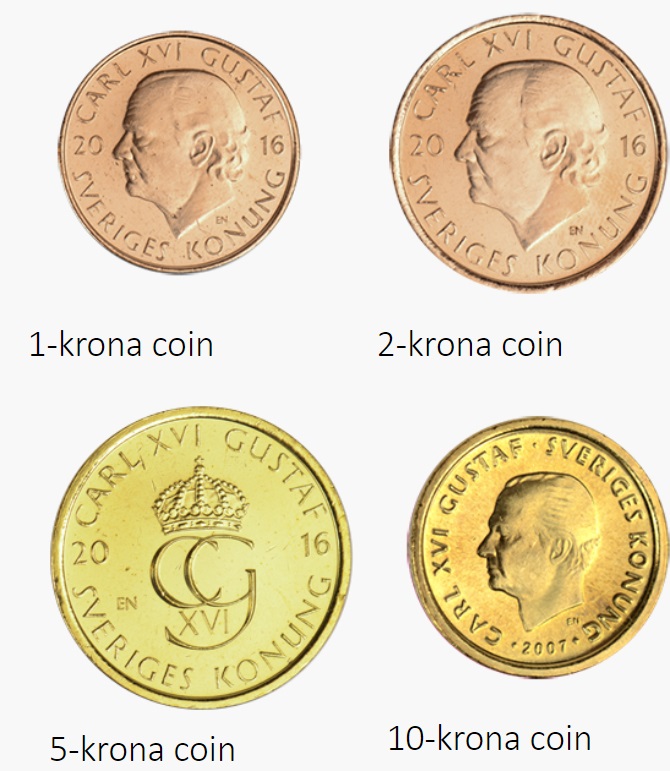
As for the obverses, all of them contain the profile effigy of the current King of Sweden, Carlos XVI Gustaf. In the 5 kr coin, the effigy is replaced by the monarch’s personal monogram.
On the reverse of all Swedish coins, the face value appears next to the symbol of the three crowns, which appear on the national coat of arms. The only exception is the 10 kr. coin, which shows the shield in its entirety. The approximate value of that currency in exchange is just under one euro.
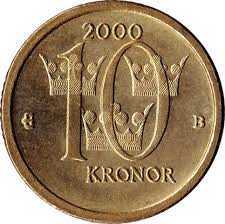
Swedish krona banknotes
There are currently 6 different denominations of Swedish banknotes in circulation (the current series was issued between 2015 and 2016):
- Banknotes of 20 kr, 50 kr, 100 kr, 200 kr, 500 kr and 1,000 kr.
The obverses feature prominent figures from the country’s history, while the reverses feature depictions of Swedish buildings, monuments, and natural landscapes.
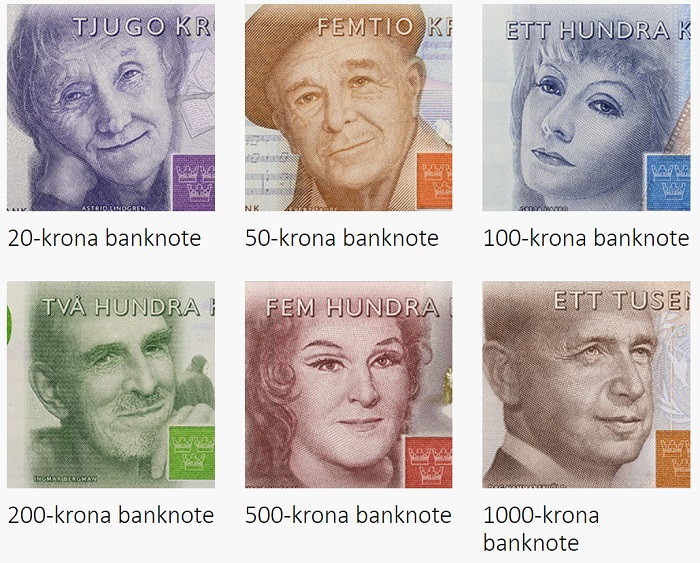
Next we will see the characteristics of each of these notes. The source of all images is from the Swedish Central Bank (Riksbank).
20 kr banknote
On the obverse of the purple twenty-crown note, the Swedish writer Astrid Lindgren (1907-2002) shares the spotlight with her most famous literary creation: Pippi Langstrom (“Pippi Longstocking”).
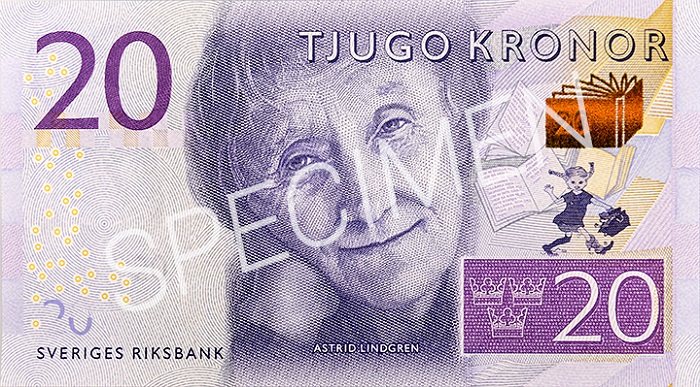
The reverse shows a landscape of Småland, the southernmost region of the country, together with an image of the Linnaea flower.
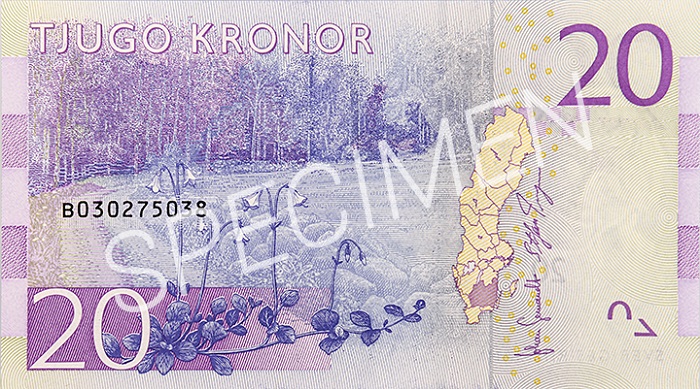
The equivalent value of this twenty Swedish crown banknote in France, in competitive suppliers in March 2023 would be about 1.77 euros.
50 kr banknote
The fifty crown note is orange in color and shows an image of the musician Evert Taube (1890-1976) on its obverse.
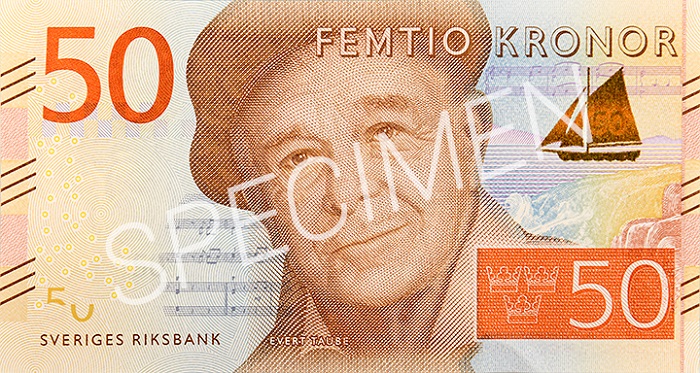
On the back are the petroglyphs of Tanum, from prehistoric times. And in the background a coastal landscape of the Bohuslän region.
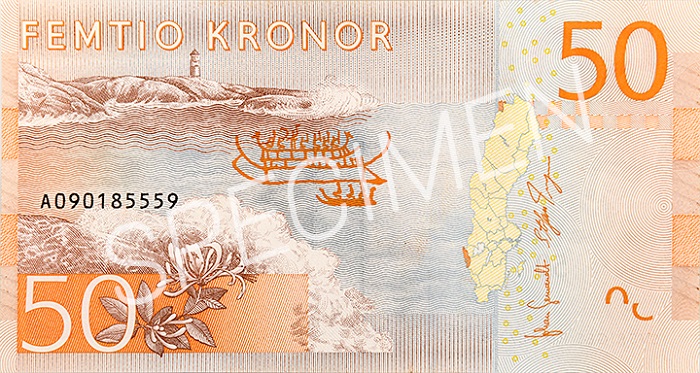
The exchange value of this banknote is around 4.42 euros in France, March 2023.
100 kr banknote
The famous Swedish actress Greta Garbo (Greta Lovisa Gustafsson), who lived from 1905 to 1990, appears on the obverse of the blue 100 kroner note.
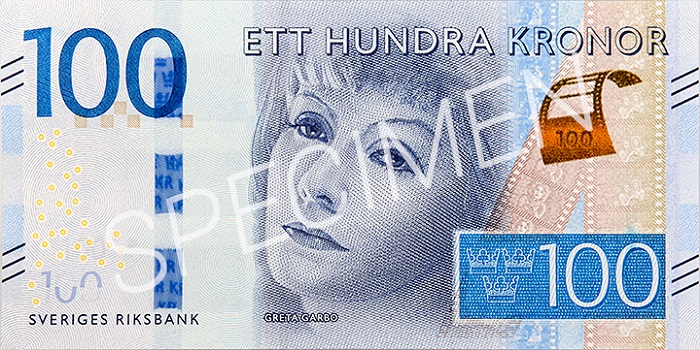
The reverse shows a landscape of Stockholm, the capital of the country.
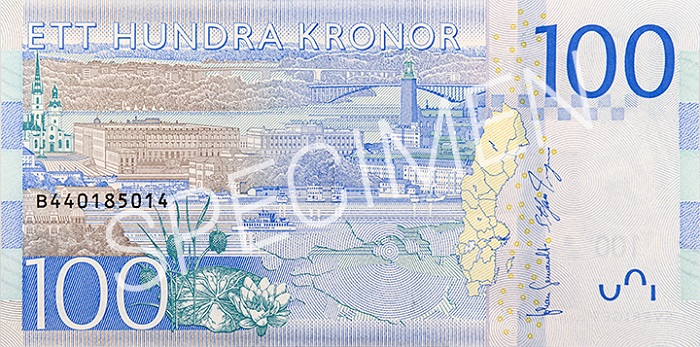
The equivalent value of this 100 crown banknote in France, March 2023, is approximately 8.85 euros.
200 kr banknote
Another legend of Swedish cinema, the film and theater director Ingmar Bergman (1918-2007), stars on the obverse of the 200 kroner note.
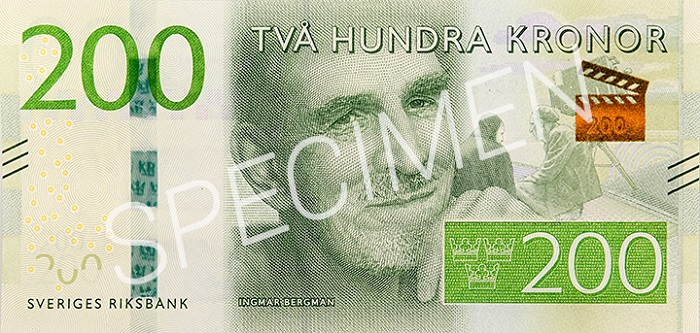
For its part, the obverse represents a typical landscape of the coasts of the island of Gotland, in the Baltic Sea.
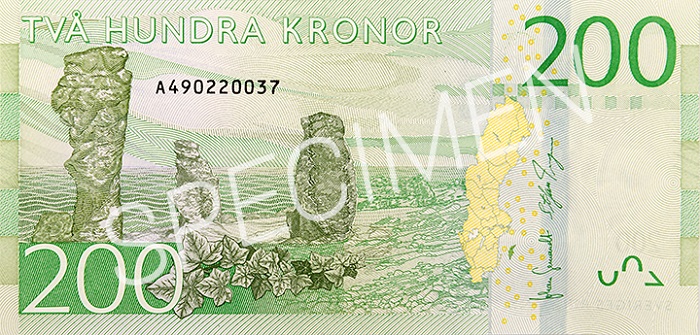
The color of this banknote is green and its exchange value in France, March 2023, of about 17.70 euros.
500 kr banknote
Undoubtedly the most controversial of the series. It shows the image of Birgit Nilsson (1918-2005), a Swedish soprano from the early 20th century famous for her performances in operas by Richard Wagner.
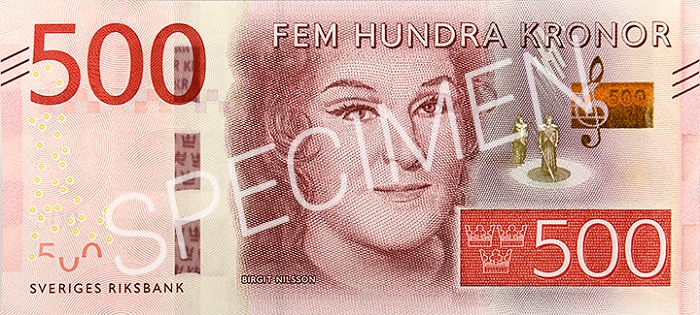
The historical circumstance occurs that a German composer was extolled in his day by Nazi Germany, which is why many voices in Sweden rose up against the design of this banknote, requesting its withdrawal, considering it a form of apology for Nazism.
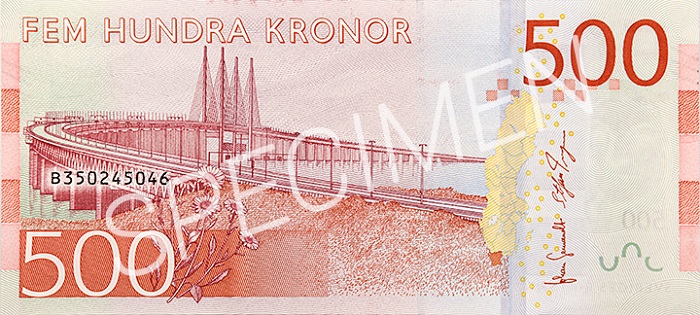
The Riksbank (Swedish National Bank) did not take these exaggerated accusations into consideration and keeps the note in circulation.
The 500 crown note is dark red in color and its approximate value in March 2023 is about 44.25 euros.
1,000 kr banknote
The highest value banknote currently issued by the National Bank of Sweden (whose exchange value is about 90 euros) is brown in color and bears the image of Dag Hammarskjöld on its obverse, a prominent Swedish economist and diplomat of the 20th century (1905 -1961).
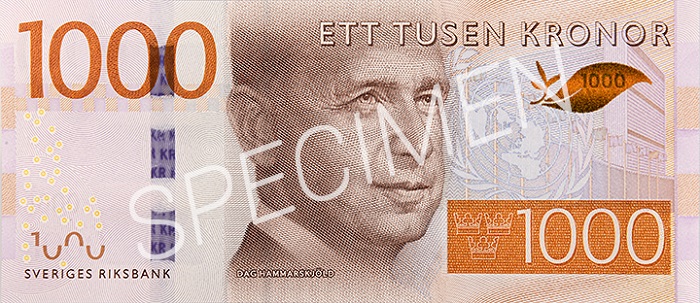
The reverse is dedicated to the Lapland region, located in the far north of the country.
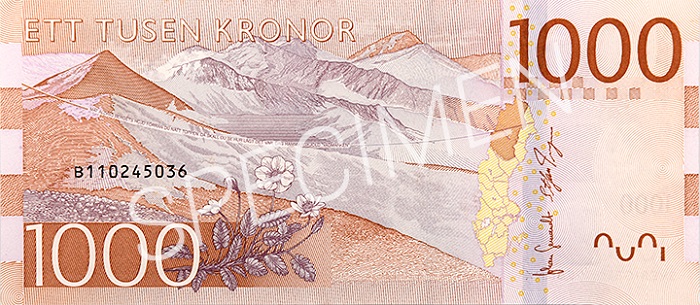
The 1000 crown banknote has an approximate equivalent value in March 2023 of about 88.50 euros in currency suppliers in France.
Euro to swedish krona currency exchange
The exchange rate of the euro against the Swedish krona oscillates continuously. If you search Google for “Euro to Swedish krona exchange” you will find dozens of websites (“currency converters”) that show you a “price” of the day.
You will also see this graph with the prices of that pair of currencies from Google Finance. Something like this (March 13, 2023):
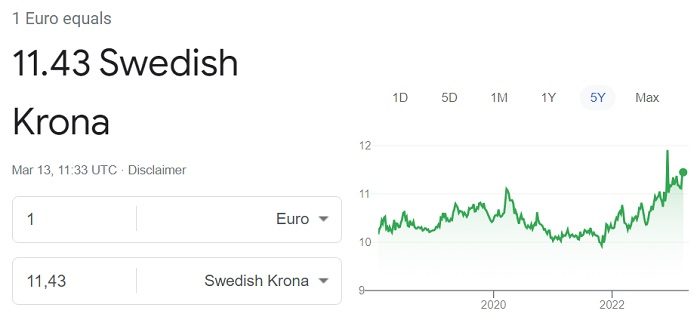
As you can see, the change in the last five years has fluctuated quite little, between SEK 10 and SEK 11 per euro. This currency is very stable and does not lose value over the years, within a few small oscillations.
But keep in mind that this graph represents the value of the Swedish krona “currency” against the euro, and not the lower real currency (paper notes).
In fact, in currency suppliers in France today you can buy Swedish crowns at an exchange rate of around 10.88 crowns per euro, in the best option and 7.80 crowns per euro at the airport. Nothing to do with the euro Swedish crown currency exchange today, of 11.43 crowns per euro.
Paper money and currency are not the same
So, when you see these values in Google and other currency converters with your mobile, keep this in mind:
-It is an unofficial rate, and therefore unreliable. In other words, if you click on the “Disclaimer” link, you will get this warning from Google Finance: “Google cannot guarantee the accuracy of the exchange rates displayed. Please confirm current rates before making a transaction that may be affected by changes in exchange rates.”
-These rates that you see are usually wholesale prices of the Swedish krona currency against the Euro currency (currency and travel money currency are not the same).
-This exchange rate can only be obtained by banks among themselves (interbank market), that is, it is impossible to obtain it as an individual.
If you need Swedish crowns in banknotes you will have to go through the ticket retail market (bank or currency supplier). This market means that the crowns have had to be “transported” by someone for you to enjoy them (or bought from travelers from Sweden, previously passing through France).
In other words, moving tickets from one place to another has logistical costs that will make their sale price more expensive (the exchange rate that will be applied by whoever sells them to you).
The Swedish krona is not a very abundant currency/currency in France, although it is not too difficult to obtain either because it is quite stable and “convertible”.
Despite this, its rate is more expensive in France than in Sweden. If you choose to buy Swedish crowns in France, it is good to anticipate the purchase and order them online to obtain a better price.
Where to exchange Swedish kronas in France
The three most popular places to exchange Swedish krona in France are banks, currency suppliers and the airport.
Of them, the least recommended place to buy is the airport and any business that charges you a commission in addition to an “exchange margin” (difference between the price for which you paid the currency and the price for which it is sold to you).
For their part, the large French banks sell and buy Swedish crowns. But apart from the exchange rate that they make you, you will have to anticipate a bank commission of between 2.5 and 3%. This means that if you change 600 euros to crowns, in addition to the change applied to you, you will pay a commission of 15 to 18 euros.
As for the currency exchange suppliers in France, they tend to have good rates (except those in airports and train stations such as Global Exchange which have very attractive exchange offices but do not give good rates).
The suppliers that collaborate with Comparer Devise do not charge you a commission and when competing with each other, you can always contract the currency suppliers that best suits you (for price, for convenience, for proximity to you or for trust).
Euro to Swedish krona rate today
To find the best euro to Swedish krona exchange rate (or vice versa), the best thing you can do is use our currency comparator.

Sin comentarios